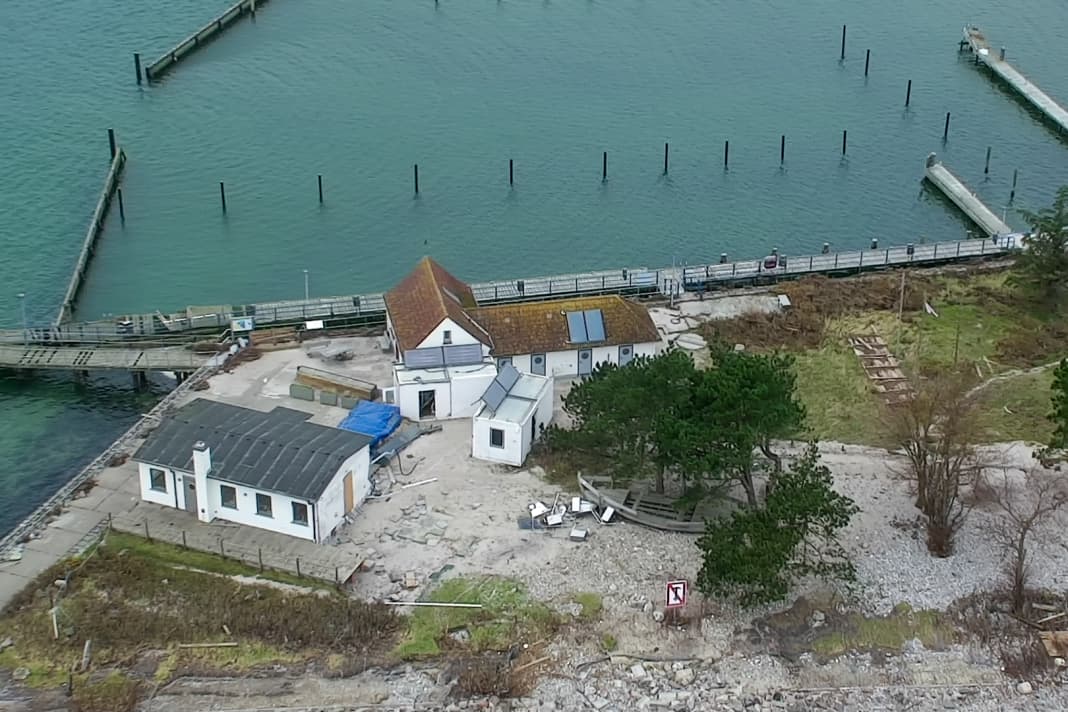Schleimünde: The consequences of the Baltic Sea storm surge - retreat by 2050?
Andreas Fritsch
· 16.11.2023






The storm surge hit the popular harbour hard. The kitchen containers of the legendary "Giftbude" pub were completely damaged. "'Giftbude' and the pilot house have water damage, but are otherwise fortunately structurally intact. However, the sewage system, power supply and heating systems have been destroyed. "All in all, the damage amounts to around one million euros," says Jens Ambsdorf from the Lighthouse Foundation, which has owned the pilot island since 2008. Nevertheless, he encourages the sailors: "The harbour will be back in operation in 2024, but probably not with a warm kitchen again, which alone would cost 200,000 euros."
The aim of the foundation is to preserve Schleimünde as a publicly accessible place, and this will continue to be done - but for how long is uncertain. "If the climate catastrophe continues like this, we will probably have to prepare ourselves for an orderly retreat from Schleimünde by around 2050." The floods in 2013 and 2019, when the peninsula was flooded for the first time, already caused expensive damage that is no longer insurable. "If we have to prepare for higher water levels every five years during easterly storms, it's clear where this will end."
The most important task now is to close the gap in the protective dam immediately, as winter and its storms are still to come. Around 30 metres of the massive stone wall has been broken by the sea and the embankment behind it has been washed away. In the meantime, an excavator has been shipped to Schleimünde to tackle the roughest clean-up work, such as collecting all the large stones that the masses of water have scattered everywhere.
After the Baltic Sea storm surge: How to deal with floods in the future is unclear
The flood also completely destroyed the viewing platform, which rested on two huge concrete foundations, and washed it free. "This is actually the old Schleimünde sewage treatment plant, but it had already been so badly damaged by storms that we had to build a new one," explains Jens Ambsdorf. The concrete parts are now to be removed.
In the long term, municipalities, the state and coastal defences on the Schlei will have to consider how to proceed. The construction of a dyke from Schleimünde to the old Falshöft lighthouse, which was already being discussed by the residents of the Schlei region after the last flood damage, has so far been clearly rejected by the coastal protection and nature conservation authorities. Their position is that Schleimünde should be left to nature as a nature reserve. If, as has been the case for years, the Baltic Sea washes over the peninsula behind the small group of trees in strong easterly winds and continues to eat its way towards the "poisonous shack", that is simply nature. The citizens' initiative "Save Schleimünde" has been criticising for years that it is dangerous and irresponsible to allow this to happen, not only because Schleimünde is worth preserving, but also because water is ultimately pushed into the Schlei through an ever-increasing opening during easterly storms. This causes the water levels there to rise faster and higher. The coastal and dyke protection authorities have not seen it that way so far. However, as dykes broke near Maasholm and Arnis, the question arises as to whether the authorities were wrong.
"But that doesn't answer the question of how to tackle flooding on the Schlei in the future. Should all towns protect themselves with structural measures, or even plan a barrage, or should certain areas be abandoned in the long term?" asks Jens Ambsdorf. An interim solution in Schleimünde could buy important time for this necessary discussion. Until the 1970s, for example, it was common practice for two employees of the district to regularly inspect the stone dam and earth embankment in front of the pilot station and repair damage on an ongoing basis. The discussion about Schleimünde could therefore only really have begun.
More about the Baltic Sea storm surge:
- Golden times for bargain hunters?
- Huge damage to the infrastructure
- Over 200 total losses - "Schilksee resembles a battlefield"
- Will the insurance companies pay for the damage?
- On board - Experiences during the night of terror
- All yachts must be salvaged by 31 October
- Dramatic depiction of the night of horror
- This wind pressure is generated on yachts during storms
- Balance of damage in the harbours
- Only minor problems for the charter season
- Salvage by professionals - the report

